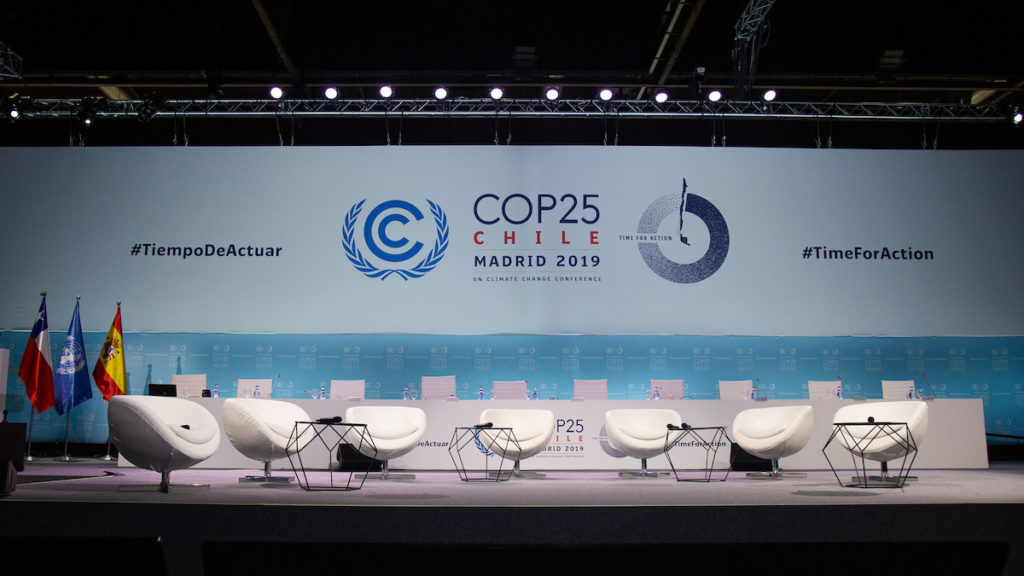In the wake of the generally disappointing negotiations at the United Nations’ 25th annual Climate Change Conference, the importance of local and regional actions has never been more clear.
The climate talks, held in Madrid earlier this month, are being denounced as one of the worst outcomes in a quarter-century of climate, demonstrating the growing gap between what scientists say the world needs to do now and what actions the world’s most powerful leaders are prepared to take.

“Most of the large emitters were missing in action or obstructive,” said Helen Mountford, a vice president at World Resources Institute. “This reflects how disconnected many national leaders are from the urgency of the science and the demands of their citizens.”
On September 20, an estimated 4 million people took to the streets worldwide in one of the largest youth-led demonstrations in history as part of “The Global Climate Strikes.” These massive demonstrations sent a powerful message that leaders around the world heard loud and clear: Do more to combat climate change, and do it now.
In more than 2,500 events convened across 163 countries on all seven continents, young people – and their adult allies – expressed a collective sense of urgency to protect the planet’s natural resources, transition away from fossil fuels, and inspire bold innovation, environmental justice and immediate action.
“You’ve been negotiating for the last 25 years, even before I was born,” said Hilda Flavia Nakabuye, a 22-year-old activist from Uganda, during a high-level plenary session with negotiators. “I’d rather fail my exams than fail my generation,” she added, in defense of her choice to skip school to join fellow students in weekly climate strikes.
Even if all countries meet the voluntary targets they have set so far, according to the scientific consensus, emissions are rising at a pace that makes storms and heat waves very likely to become more severe, and puts coastal cities at risk.
Luckily, local governments aren’t waiting for national or international leadership.
More than 1,200 cities around the world – including 28 cities in California – have already declared a state of “climate emergency,” Oxford Dictionary’s 2019 word of the year.
The climate emergency resolutions commit the cities to reversing global warming and ending greenhouse gas emissions as quickly as possible and no later than 2030. These agreements immediately initiate an effort to safely draw down carbon from the atmosphere, ensuring a just transition for residents and accelerating adaptation and resilience strategies that help prepare us for intensifying local climate impacts.
More than two-dozen large cities (including San Francisco and Los Angeles) have already reached peak emissions, according to the C40 Cities Climate Leadership Group, an international network dedicated to reducing emissions and sharing best practices. Each of these cities has reduced emissions over at least five years, while their population and economies have grown.
Getting to Zero
In April, Mayor Eric Garcetti launched Los Angeles’ own Green New Deal, which calls for a zero-emission bus-and-train network with new community car-charging stations along with zero-carbon requirements that all new buildings be powered and cooled without using fossil fuels. Under the plan, no waste would be sent to landfills by 2050. The plan also envisions a carbon-free power grid that will shift from coal and natural gas to 100%-renewable energy by 2045 – primarily through solar, wind and hydroelectric sources. The proposal also sets a goal of creating as many as 300,000 new jobs to build and support these cleaner forms of energy.
Meanwhile in San Francisco, Mayor London Breed has pledged to reduce the city’s landfill disposal by 50% by 2030 and ensure all buildings are net-zero emissions by 2050, which means moving away from natural gas and only permitting all-electric buildings, and supplying electricity from carbon-free sources.
Further north, the Capital Region is also ramping up climate-mitigation efforts. Sacramento Mayor Darrell Steinberg and West Sacramento Mayor Christopher Cabaldon have established a cross-sector commission to identify measures that their two cities can take to reach carbon neutrality by 2045, focusing on decarbonizing transportation and buildings and increasing community health and resiliency.
“By working together, we can accelerate and shape the transition to a clean-energy economy that’s already occurring to ensure that it benefits our local businesses and residents. We can strengthen Sacramento’s position as a hub for investment in clean technologies and promote social equity and economic prosperity for all,” said Steinberg.
The City of San Jose rolled out a new clean-energy program – the largest single-city community choice energy program in the country – that is delivering 100%-renewable electricity to city residents. San Jose also committed to enacting regulations and policies to ensure that all new buildings operate at net-zero energy by 2050. San Jose is also the largest city to bans on natural gas in new buildings and they aren’t alone.
Getting Away from Gas
Since June, a dozen cities have banned natural-gas equipment in new buildings. Berkeley was the first municipality in California, followed by San Jose, Mountain View, Santa Rosa and Brisbane. A half-dozen other cities have passed laws to strongly encourage all-electric construction, while not banning fossil fuels outright.
The Bay Area Air Quality Management District has committed to “Diesel Free by ’33” that seeks to end diesel use in the nine-county region within 15 years. The pledge has already been signed by more than 75 government and business leaders to date, including the mayors of Oakland, San Jose, Richmond, Berkeley, Fremont, Albany, Benicia, Cupertino, Emeryville and other cities, as well as the boards of supervisors for Contra Costa, San Mateo and Sonoma counties.
Fighting Back against Large Polluters
In San Diego County, the City of Imperial Beach is pursuing its own lawsuit looking to force 18 energy companies in the oil and coal sectors to pay for damages associated with rising sea levels.
“We’re going full-speed ahead,” Imperial Beach Mayor Serge Dedina said. “The reality is the fossil fuel industry has caused climate change and they need to pay for it.”
No specific dollar figure is yet requested but the lawsuit says climate change will lead to coastal flooding in Imperial Beach that will result in $38 million in damages to residential and commercial buildings, and erosion that will affect property valued at more than $106 million.
Other California cities filing similar suits include Richmond and Santa Cruz, and San Mateo and Marin counties.
Climate-Smart Housing Strategies
Moving forward, local policymakers must step up to make dramatic changes in land-use and transportation policies and investments. Among its recommendations that local and regional leaders can implement, the United Nations Emissions Gap Report, for example, calls for lifting zoning bans on multifamily housing and cites the environmental benefits of building “multifamily residences in denser urban areas.” (P.58-9, Section 7.2.3)
Oregon is the first state to eliminate single-family zoning in residential areas across an entire state.
Governor Katie Brown signed House Bill 2001 in law, requiring cities with more than 25,000 residents to allow duplexes, triplexes, fourplexes and “cottage clusters” on every lot on land currently zoned for single-family housing. Cities with at least 10,000 residents are required to allow duplexes in single-family zones.
In 2018, Minneapolis became the first major U.S. city to end single-family zoning. With a 12-1 vote, the City Council passed Minneapolis 2040, a comprehensive plan to permit two- or three-family homes throughout the city’s residential neighborhoods, abolish parking minimums for all new construction, and allow high-density buildings along transit corridors.
Mayors in some of California’s biggest cities are likewise considering doing away with zoning that allows only for single-family homes.
At a housing forum in the Bay Area over the summer, Oakland Mayor Libby Schaaf and Sacramento Mayor Darrell Steinberg said they supported ending single-family-only zoning in their communities, while San Jose Mayor Sam Liccardo said his city was also considering doing so. The trio has endorsed Senate Bill 50, as has San Francisco Mayor London Breed.
This month, the Berkeley City Council took a big step to advance transit-oriented development. The council unanimously agreed to approve terms for a memorandum of understanding with BART to advance what could put as many as 1,700 new housing units (with at least 35% of the units set aside for low-income families) on parking lots at its North Berkeley and Ashby stations.
The deal is a test case of a new law (Assembly Bill 2923) that makes it easier for BART to develop new homes on property it owns around the Bay Area by requiring cities to change their zoning to accommodate BART development, and clearing the way for BART to adopt transit-oriented development zoning standards that establish minimum local zoning requirements for BART-owned land near its stations. These changes could result in an estimated increase of 10,000 to 20,000 new transit-oriented housing units in the region.
The Next Generation of Climate Leaders
The Local Government Commission is helping to implement local climate actions and foster the next generation of leaders through its CivicSpark AmeriCorps program in partnership with the Governor’s Office of Planning and Research. To date, fellows have provided approximately over 350,000 hours toward almost 400 climate projects for over 150 participating local governments, including the completion of 301 inventories, benchmarking or assessment reports, 258 climate policies, 51 climate action plans, 39 climate adaptation assessments and 26 climate research reports.
CivicSpark prioritizes on-the-ground action by building momentum through a range of in-person outreach activities, including over 500 workshops, presentations, and community events. Our Fellows have engaged over 37,000 community members and supported over 3,000 volunteers who have contributed an additional 12,000 hours to local community activities.
A broad range of climate projects have been completed that include:
- An Electric Vehicle Ready Blueprint for Ventura County to help set a course toward wide-scale EV adoption by 2030. CivicSpark Fellow Andrew Wakelee collected data on charging station locations and engaged local stakeholders to gather feedback. The final EV Blueprint will include an online charging map and will enable the County to access additional state funding to install more charging stations and expand local EV programs.
- A five-step building electrification plan for the City of Emeryville that outlines a path to equitably decarbonize the City’s municipal buildings. Fellow Edgar Barraza played an instrumental role in developing elements of the plan that address racial and gender equity in electrification.
- A Green Commuter program for County of Santa Barbara’s employees (supported by fellow Sean Burns) aims to shift employee-commuting trips to low carbon or no carbon options. During the CivicSpark service year, the County’s Air Pollution Control District adopted the Green Commuter Guidelines, and the Board of Supervisors allocated $50,000 to support implementation.
While CivicSpark supports the implementation of foundational climate projects like these, it is, perhaps more importantly, also creating a pipeline of new climate leaders – a recent survey found over 83% of CivicSpark alumni are in a sustainability career path and 73% are working in the public sector.
The Time Is Now, the Place Is Here
While national and international leadership is certainly needed, communities aren’t waiting to take critical steps now to respond to the growing urgency of climate action. Significant progress must be made at all levels of government in order to avoid the worst impacts of climate change but regardless of the action or lack of action by some, communities can advance strategies that curb current climate impacts and increase local resiliency.
Resources
- C40 Cities
- Los Angeles’ Green New Deal
- UN Emissions Gap Report 2019
- CivicSpark Program
- Building Decarbonization Coalition
- The Climate Mobilization
—————————————————–

